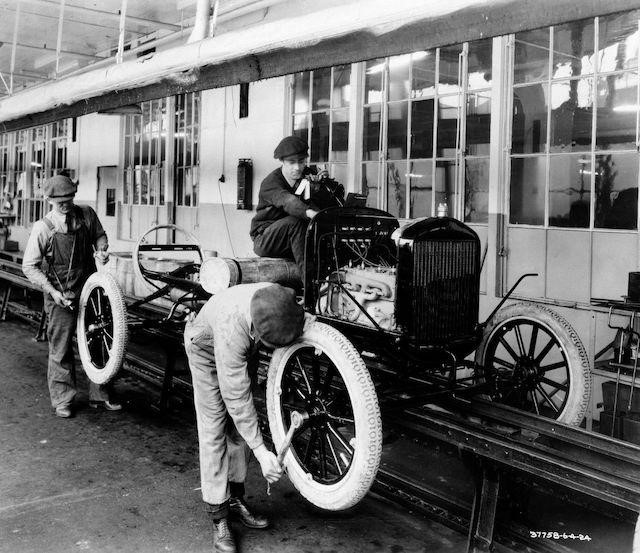Table of Contents
ToggleDid you Know? The word LEXUS is an acronym for Luxury EXports to the US.
Do you know the story behind why Toyota created the Lexus automotive brand in the first place? If you don’t, read our article to learn everything about it. Understand how Kaizen helped Toyota master Henry Ford’s world-renowned Assembly/Production Line style of car manufacturing and then help out an American Car company GM a few decades later. Toyota came full circle by mastering the production line with Kaizen principles and teaching Americans how to do it better.
Toyota’s tryst with Kaizen
Kaizen in Japanese means never-ending improvement. Kaizen, deeply interwoven into Toyota’s very fabric, signifies the brand’s relentless pursuit of excellence. This concept, central to Toyota’s ambitions both domestically and internationally, translates to an ongoing quest for betterment, guided by five core values: collaboration, self-discipline, heightened morale, constructive feedback loops, and the encouragement of innovative ideas.

This philosophy not only underscores the essence of the Japanese approach to work but also reflects Toyota’s commitment to superior car manufacturing. Although the term predates the company, Toyota’s embodiment of kaizen principles is so profound that they are often mistakenly thought to have originated the concept. No other corporation embodies the principles of continuous improvement as thoroughly as Toyota does.
Read: What is Kaizen? Principles, Advantages, and more
How Toyota Embraced True Japanese Kaizen Spirit
Toyota has embraced Kaizen in every single of their cars beginning from their humble Corolla in the past to their latest Camry. The principles of Kaizen are also implemented in their luxury arm Lexus brand.
As highlighted previously in the article, it was Henry Ford who visualized and pioneered the assembly line process for car manufacturing. Previously only one car was built at a time. Henry Ford’s invention completely changed the dynamics of car manufacturing forever globally, and Toyota was one of the first companies to study its implementation from Ford Motors back in the day.

Toyota being a Japanese company embraced their inner Kaizen spirit and did not just copy a good idea from Ford Motors, but they went on to make it even better. In a true Kaizen process, Toyota decided that once a process is carried out efficiently by a certain group of people, later it can achieve the same process with a smaller group, which in turn freed other personnel in the area to move around, learn new tasks and work even more efficiently. This never-ending or constant improvement is the true spirit of Kaizen, which Toyota imbibed in the very fabric of conducting their business worldwide.

Then came General Motors in the ’80s, knocking on the doors of Toyota for them to help out with their manufacturing plant NUMMI in Fremont, which was one of the worst-performing plants. The plant was infamous, where the workforce turned up drunk, and some did not even turn up at all. Toyota, with its highly improved manufacturing process, was able to drastically turn around the output of GM while retaining 85% of the previous workforce.
Today, Toyota is one of the top-selling brands in the US. The Toyota and Lexus brands from their portfolio are accounted for the bulk of sales in the US with a 7% growth and it being the biggest single market for the car manufacturer.
Why did Toyota create Lexus?
In the 1980s, the term luxury car was firmly within the cusp of European car brands like Mercedes, Audi, and BMW. Mercedes, especially, had the W126 S-Class Model in its portfolio, which garnered the title of being “The Best Car in The World.” Many automotive publications at that time even went on to say that there was no other car like this anywhere in the World.

This certainly irked Toyota which was the face of cheerful, cheap, and reliable cars from Japan. Many assumed that Toyota was incapable of entering into the luxury car segment with its philosophies. Though Toyota had become a household name in the entry-car and mid-level car segment, the luxury car segment was something that was out of reach.
It was in 1983, that the then-chairman Eiji Toyoda issued a challenge to his employees within the organization to build the world’s best car. The project was named F1 (Flagship One), which was to develop the Lexus LS 400 to expand Toyota’s car portfolio into the premium luxury segment.

Especially in the early 1980s, the Toyota brand was only seen in the overseas market as “cheap and cheerful” for its cars, a mindset that was extremely difficult to change. Hence, they needed a new name, new thinking, and newer products that represented luxury and that would see the light of day in Europe and the US rather than in their backyard Japan. They were pretty serious about this.
This is when Toyota created a masterstroke of a plan to launch a new and separate luxury car division in Lexus. It is said that the name Lexus is an anagram for Luxury EXports to the US, though not confirmed, if so, it would be a stroke of genius if it was in any way.
Now, in 1989, Toyota’s ambition to ensure Lexus was the best of everything, even superior to what the European manufacturers were offering, was something of sheer automotive audacity, to say the least. Toyota was hell-bent on dethroning the Mercedes-Benz S-Class W126 as “The Best Car in the World” with their all-new Lexus LS 400. They were up against everything from the beginning about public perception of who Toyota was and how they could achieve something like this. It was a David vs Goliath story for the ages.
Did you know? Lexus sold over 824,258 units globally in 2023, which was 132% more than the previous year.
With sheer perseverance, Kaizen process knowledge, stringent quality checks, and top workmanship, the Lexus LS 400 was a superior car to the Mercedes S-Class W126. Every nook and corner of the Lexus LS 400 spoke Luxury, with a powerful 4-litre V8 engine, which in those days became the benchmark for V8 engines and kept that mantle for the next 20 years or so. Toyota had achieved something impossible with the Lexus brand and their first car, the LS 400, and that too on their first try. We certainly need to applaud Toyota for its efforts here. This step led the whole Automotive industry to take notice of their efforts and led to a drastic change in terms of creating a luxury car.
However, the public perception of the car received mixed reviews, and hardcore drivers felt the car was too good to be true, too quiet, and found a disconnect as it was a perfect engineering marvel that nobody even dared to make. Maybe customers were not used to such innovation and performance from so-called luxury cars at that time.

The one area where LS400 came in trumps was when every European luxury carmaker collectively took notice of this engineering marvel. Mercedes engineers bought one of the cars, took it apart, and silently acknowledged that they were beaten at their own game. The Japanese carmaker Toyota, with its Kaizen principles, had arrived on the luxury car scene with the Lexus brand, and the automotive industry would never be the same again.
Conclusion
Toyota implemented Kaizen in its true spirit, which was to continuously improve every aspect of the manufacturing process. They regularly adapted, adjusted, and constantly improved to make things better. For this, they were rewarded when they became the Largest Automaker in the world in 2008.
So, Kaizen is not just a word; it is, in fact, a way of life at Toyota; ask anybody working there. It is something instilled from Day 1 at Toyota, and for any employee who joins Toyota, it is their number 1 job to implement Kaizen principles in the workplace and in their personal lives as well. Today, Kaizen is not limited to just the Automotive industry; it is applied across industry sectors worldwide. If you are looking to know more about Kaizen and want to implement its principles in all glory within your teams or organizations on the whole, take part in Spoclearn’s Kaizen training program to gain a complete understanding of Kaizen benefits, Kaizen costing, and more.
